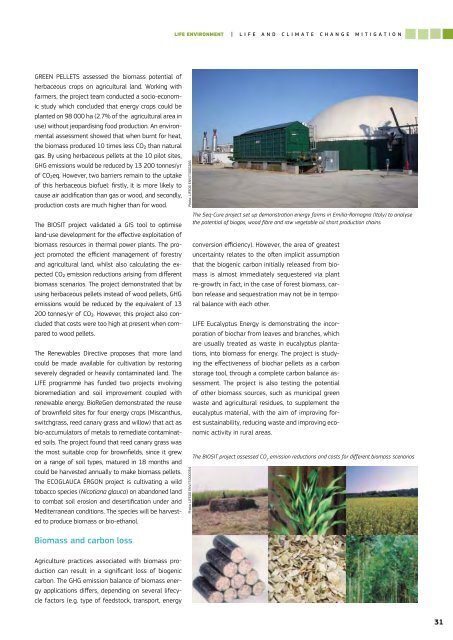You also want an ePaper? Increase the reach of your titles
YUMPU automatically turns print PDFs into web optimized ePapers that Google loves.
LIFE ENVIRONMENT |LIFE and Climate CHANGE mitigationGREEN PELLETS assessed the biomass potential ofherbaceous crops on agricultural land. Working withfarmers, the project team conducted a socio-economicstudy which concluded that energy crops could beplanted on 98 000 ha (2.7% of the agricultural area inuse) without jeopardising food production. An environmentalassessment showed that when burnt for heat,the biomass produced 10 times less CO2 than naturalgas. By using herbaceous pellets at the 10 pilot sites,GHG emissions would be reduced by 13 200 tonnes/yrof CO2eq. However, two barriers remain to the uptakeof this herbaceous biofuel: firstly, it is more likely tocause air acidification than gas or wood, and secondly,production costs are much higher than for wood.The BIOSIT project validated a GIS tool to optimiseland-use development for the effective exploitation ofbiomass resources in thermal power plants. The projectpromoted the efficient management of forestryand agricultural land, whilst also calculating the expectedCO2 emission reductions arising from differentbiomass scenarios. The project demonstrated that byusing herbaceous pellets instead of wood pellets, GHGemissions would be reduced by the equivalent of 13200 tonnes/yr of CO2. However, this project also concludedthat costs were too high at present when comparedto wood pellets.The Renewables Directive proposes that more landcould be made available for cultivation by restoringseverely degraded or heavily contaminated land. TheLIFE programme has funded two projects involvingbioremediation and soil improvement coupled withrenewable energy. BioReGen demonstrated the reuseof brownfield sites for four energy crops (Miscanthus,switchgrass, reed canary grass and willow) that act asbio-accumulators of metals to remediate contaminatedsoils. The project found that reed canary grass wasthe most suitable crop for brownfields, since it grewon a range of soil types, matured in 18 months andcould be harvested annually to make biomass pellets.The ECOGLAUCA ÉRGON project is cultivating a wildtobacco species (Nicotiana glauca) on abandoned landto combat soil erosion and desertification under aridMediterranean conditions. The species will be harvestedto produce biomass or bio-ethanol.Biomass and carbon lossPhoto: LIFE06 ENV/IT/000266Photo: LIFE00 ENV/IT/000054The Seq-Cure project set up demonstration energy farms in Emilia-Romagna (Italy) to analysethe potential of biogas, wood fibre and raw vegetable oil short production chainsconversion efficiency). However, the area of greatestuncertainty relates to the often implicit assumptionthat the biogenic carbon initially released from biomassis almost immediately sequestered via plantre-growth; in fact, in the case of forest biomass, carbonrelease and sequestration may not be in temporalbalance with each other.LIFE Eucalyptus Energy is demonstrating the incorporationof biochar from leaves and branches, whichare usually treated as waste in eucalyptus plantations,into biomass for energy. The project is studyingthe effectiveness of biochar pellets as a carbonstorage tool, through a complete carbon balance assessment.The project is also testing the potentialof other biomass sources, such as municipal greenwaste and agricultural residues, to supplement theeucalyptus material, with the aim of improving forestsustainability, reducing waste and improving economicactivity in rural areas.The BIOSIT project assessed CO 2emission reductions and costs for different biomass scenariosAgriculture practices associated with biomass productioncan result in a significant loss of biogeniccarbon. The GHG emission balance of biomass energyapplications differs, depending on several lifecyclefactors (e.g. type of feedstock, transport, energy31


